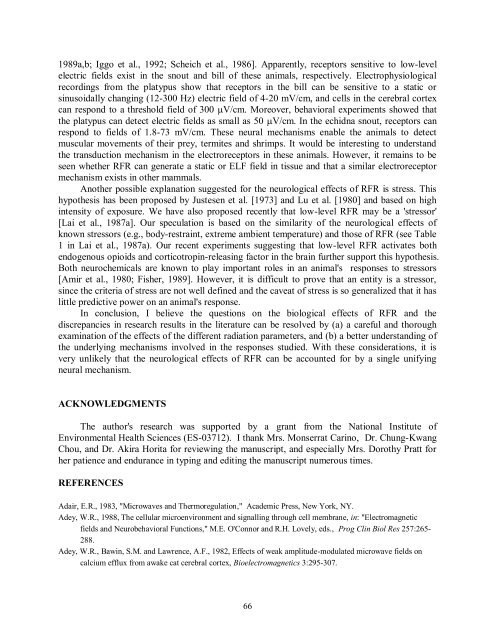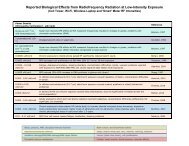1989a,b; Iggo et al., 1992; Scheich et al., 1986]. Apparently, receptors sensitive to low-level electric fields exist in the snout <strong>and</strong> bill of these animals, respectively. Electrophysiological recordings from the platypus show that receptors in the bill can be sensitive to a static or sinusoidally changing (12-300 Hz) electric field of 4-20 mV/cm, <strong>and</strong> cells in the cerebral cortex can resp<strong>on</strong>d to a threshold field of 300 V/cm. Moreover, behavioral experiments showed that the platypus can detect electric fields as small as 50 V/cm. In the echidna snout, receptors can resp<strong>on</strong>d to fields of 1.8-73 mV/cm. These neural mechanisms enable the animals to detect muscular movements of their prey, termites <strong>and</strong> shrimps. It would be interesting to underst<strong>and</strong> the transducti<strong>on</strong> mechanism in the electroreceptors in these animals. However, it remains to be seen whether RFR can generate a static or ELF field in tissue <strong>and</strong> that a similar electroreceptor mechanism exists in other mammals. Another possible explanati<strong>on</strong> suggested <str<strong>on</strong>g>for</str<strong>on</strong>g> the neurological effects of RFR is stress. This hypothesis has been proposed by Justesen et al. [1973] <strong>and</strong> Lu et al. [1980] <strong>and</strong> based <strong>on</strong> high intensity of exposure. We have also proposed recently that low-level RFR may be a 'stressor' [Lai et al., 1987a]. Our speculati<strong>on</strong> is based <strong>on</strong> the similarity of the neurological effects of known stressors (e.g., body-restraint, extreme ambient temperature) <strong>and</strong> those of RFR (see Table 1 in Lai et al., 1987a). Our recent experiments suggesting that low-level RFR activates both endogenous opioids <strong>and</strong> corticotropin-releasing factor in the brain further support this hypothesis. Both neurochemicals are known to play important roles in an animal's resp<strong>on</strong>ses to stressors [Amir et al., 1980; Fisher, 1989]. However, it is difficult to prove that an entity is a stressor, since the criteria of stress are not well defined <strong>and</strong> the caveat of stress is so generalized that it has little predictive power <strong>on</strong> an animal's resp<strong>on</strong>se. In c<strong>on</strong>clusi<strong>on</strong>, I believe the questi<strong>on</strong>s <strong>on</strong> the biological effects of RFR <strong>and</strong> the discrepancies in research results in the literature can be resolved by (a) a careful <strong>and</strong> thorough examinati<strong>on</strong> of the effects of the different radiati<strong>on</strong> parameters, <strong>and</strong> (b) a better underst<strong>and</strong>ing of the underlying mechanisms involved in the resp<strong>on</strong>ses studied. With these c<strong>on</strong>siderati<strong>on</strong>s, it is very unlikely that the neurological effects of RFR can be accounted <str<strong>on</strong>g>for</str<strong>on</strong>g> by a single unifying neural mechanism. ACKNOWLEDGMENTS The author's research was supported by a grant from the Nati<strong>on</strong>al Institute of Envir<strong>on</strong>mental Health Sciences (ES-03712). I thank Mrs. M<strong>on</strong>serrat Carino, Dr. Chung-Kwang Chou, <strong>and</strong> Dr. Akira Horita <str<strong>on</strong>g>for</str<strong>on</strong>g> reviewing the manuscript, <strong>and</strong> especially Mrs. Dorothy Pratt <str<strong>on</strong>g>for</str<strong>on</strong>g> her patience <strong>and</strong> endurance in typing <strong>and</strong> editing the manuscript numerous times. REFERENCES Adair, E.R., 1983, "Microwaves <strong>and</strong> Thermoregulati<strong>on</strong>," Academic Press, New York, NY. Adey, W.R., 1988, The cellular microenvir<strong>on</strong>ment <strong>and</strong> signalling through cell membrane, in: "Electromagnetic fields <strong>and</strong> Neurobehavioral Functi<strong>on</strong>s," M.E. O'C<strong>on</strong>nor <strong>and</strong> R.H. Lovely, eds., Prog Clin Biol Res 257:265- 288. Adey, W.R., Bawin, S.M. <strong>and</strong> Lawrence, A.F., 1982, <str<strong>on</strong>g>Effects</str<strong>on</strong>g> of weak amplitude-modulated microwave fields <strong>on</strong> calcium efflux from awake cat cerebral cortex, Bioelectromagnetics 3:295-307. 66
Akyel, Y., Hunt, E.L., Gambrill, C., Varga, Jr. C., 1991, Immediate postexposure effects of high-peak-power microwave pulses <strong>on</strong> operant behavior of Wistar rats, Bioelectromagnetics 12:183-195. Albert, E.N., 1977, Light <strong>and</strong> electr<strong>on</strong> microscopic observati<strong>on</strong>s <strong>on</strong> the blood-brain barrier after microwave irradiati<strong>on</strong>, in: "Symposium <strong>on</strong> Biological <str<strong>on</strong>g>Effects</str<strong>on</strong>g> <strong>and</strong> Measurement of Radio Frequency Microwaves," D.G. Hazzard, ed., HEW Publicati<strong>on</strong> (FDA) 77-8026, Rockville, MD. Albert, E.N., 1979a, Reversibility of microwave induced blood-brain barrier permeability, Radio Sci 14:323-327. Albert, E.N., 1979b, Current status of microwave effects <strong>on</strong> the blood-brain barrier, J Microwave Power 14:281-285. Albert, E.N., <strong>and</strong> DeSantis, M., 1975, Do microwaves alter nervous system structure? Ann NY Acad Sci 247:87-108. Albert, E.N., <strong>and</strong> DeSantis, M., 1976, Histological observati<strong>on</strong>s <strong>on</strong> central nervous system, in: "Biological <str<strong>on</strong>g>Effects</str<strong>on</strong>g> of Electromagnetic Waves," vol. 1, C.C. Johns<strong>on</strong> <strong>and</strong> M.C. Shore, eds., HEW Publicati<strong>on</strong> (FDA) 77-8010, Rockville, MD. Albert, E.N., <strong>and</strong> Kerns, J.M., 1981, Reversible microwave effects <strong>on</strong> the blood-brain barrier, Brain Res 230:153- 164. Albert, E.N., <strong>and</strong> Sherif, M., 1988, Morphological changes in cerebellum of ne<strong>on</strong>atal rats exposed to 2.45 GHz microwaves, in: "Electromagnetic Fields <strong>and</strong> Neurobehavioral Functi<strong>on</strong>s," M.E. O'C<strong>on</strong>nor <strong>and</strong> R.H. Lovely, eds., Prog Clin Biol Res 257: 135-151. Albert, E.N., Sherif, M.F., <strong>and</strong> Papadopoulos, N-J., 1981a, <str<strong>on</strong>g>Effects</str<strong>on</strong>g> of n<strong>on</strong>-i<strong>on</strong>izing radiati<strong>on</strong> <strong>on</strong> the Purkinje cells of the uvula in squirrel m<strong>on</strong>key cerebellum, Bioelectromagnetics 2:241-246. Albert, E.N., Sherif, M.F., Papadopoulos, N.J., Slaby, F.J., <strong>and</strong> M<strong>on</strong>ahan, J., 1981b, Effect of n<strong>on</strong>i<strong>on</strong>izing radiati<strong>on</strong> <strong>on</strong> the Purkinje cells of the rat cerebellum, Bioelectromagnetics 2:247-257. Altman, J., 1975, <str<strong>on</strong>g>Effects</str<strong>on</strong>g> of interference with cerebellar maturati<strong>on</strong> <strong>on</strong> the development of locomoti<strong>on</strong>: an experimental model of neurobehavioral retardati<strong>on</strong>, in: "Brain Mechanisms in Mental Retardati<strong>on</strong>," N.A. Buchwald <strong>and</strong> M.A.B. Brazier, eds., Academic Press, New York, NY. Amir, S., Brown, Z.W., <strong>and</strong> Amit, Z., 1980, The role of endorphins in stress: evidence <strong>and</strong> speculati<strong>on</strong>s, Neurosci Biobehav Rev 4:77-86. Arber, S.L., <strong>and</strong> Lin, J.C., 1985, Microwave-induced changes in nerve cells: effects of modulati<strong>on</strong> <strong>and</strong> temperature, Bioelectromagnetics 6:257-270. Ashani, Y., Henry, F.H., <strong>and</strong> Catravas, G.N., 1980, Combined effects of anticholinesterase drugs <strong>and</strong> low-level microwave radiati<strong>on</strong>, Radiat Res 84:469-503. Atweh, S., Sim<strong>on</strong>, J.R., <strong>and</strong> Kuhar, M.J., 1975, Utilizati<strong>on</strong> of the sodium-dependent high-affinity choline uptake in vitro as a measure of activity of cholinergic neur<strong>on</strong>s in vivo, Life Sci 17:1534-1544. Baranski, S., 1972, Histological <strong>and</strong> histochemical effects of microwave irradiati<strong>on</strong> <strong>on</strong> the central nervous system of rabbits <strong>and</strong> guinea pigs, Am J Physiol Med 51:182-190. Baranski, S., <strong>and</strong> Edelwejn, Z., 1968, Studies <strong>on</strong> the combined effects of microwaves <strong>and</strong> some drugs <strong>on</strong> bioelectric activity of the rabbit central nervous system, Acta Physiol Pol<strong>on</strong>, 19:37-50. Baranski, S., <strong>and</strong> Edelwejn, Z., 1974, Pharmacological analysis of microwave effects <strong>on</strong> the central nervous system in experimental animals, in: "Biological <str<strong>on</strong>g>Effects</str<strong>on</strong>g> <strong>and</strong> Health Hazards of Microwave Radiati<strong>on</strong>: Proceedings of an Internati<strong>on</strong>al Symposium," P. Czerski, et al., eds., Polish Medical Publishers, Warsaw. Bawin, S.M., Gavalas-Medici, R.J., <strong>and</strong> Adey, W.R., 1973, <str<strong>on</strong>g>Effects</str<strong>on</strong>g> of modulated very high frequency fields <strong>on</strong> specific brain rhythms in cats, Brain Res 58:365-384. Bawin, S.M., Kaczmarek, L.K., <strong>and</strong> Adey, W.R., 1975, <str<strong>on</strong>g>Effects</str<strong>on</strong>g> of modulated VHF fields <strong>on</strong> the central nervous system, Annals NY Acad Sci 247:74-81. Bawin, S.M., Adey, W.R., <strong>and</strong> Sabbot, I.M., 1978, I<strong>on</strong>ic factors in release of 45 Ca 2+ from chicken cerebral tissue by electromagnetic fields, Proc Nat'l Acad Sci USA 75:6314-6318. Bens<strong>on</strong>, E.B., Lange, D.G., Fujimoto, J.M., <strong>and</strong> Ishi, T.K., 1983, <str<strong>on</strong>g>Effects</str<strong>on</strong>g> of acute microwave irradiati<strong>on</strong> <strong>on</strong> phenobarbital sleep <strong>and</strong> dispositi<strong>on</strong> to brain in mice, J Toxicol Envir<strong>on</strong> Health 11:261-274. 67
- Page 1 and 2:
SECTION 9 _________________________
- Page 3 and 4:
I. Introduction This chapter is a b
- Page 5 and 6:
Krause et al. [2000a] reported that
- Page 7 and 8:
Cao et al. [2000] showed that the a
- Page 9 and 10:
There have been reports suggesting
- Page 11 and 12:
different characteristics of the de
- Page 13 and 14:
IX. References Aalto S, Haarala C,
- Page 15 and 16: Galloni P, Parazzini M, Piscitelli
- Page 17 and 18: Krause CM, Sillanmaki L, Koivisto M
- Page 19 and 20: Regel SJ, Negovetic S, Roosli M, Be
- Page 22 and 23: Appendix 9-A NEUROLOGICAL EFFECTS O
- Page 24 and 25: pathways are well studied such as t
- Page 26 and 27: schedules generally produce a highe
- Page 28 and 29: monkeys were exposed to continuous-
- Page 30 and 31: in horseradish peroxidase permeabil
- Page 32 and 33: dependent increase in the entry of
- Page 34 and 35: of the brain stem, where the cochle
- Page 36 and 37: of a neurotransmitter should be inv
- Page 38 and 39: hippocampus was blocked by pretreat
- Page 40 and 41: speculated that the receptor change
- Page 42 and 43: Sanders et al. [1984] further teste
- Page 44 and 45: In more recent studies, Blackman ex
- Page 46 and 47: oxidase inhibitors, but was not sig
- Page 48 and 49: stair-case test for</strong
- Page 50 and 51: pulses, 500 pps, 1 mW/cm 2 , SAR 0.
- Page 52 and 53: D'Andrea et al. [1979, 1980] report
- Page 54 and 55: In another experiment, Carroll et a
- Page 56 and 57: the spokes of a wheel. In this task
- Page 58 and 59: Lebovitz [1980] also studied the ef
- Page 60 and 61: esumed when colonic temperature ret
- Page 62 and 63: frequencies of RFR produce differen
- Page 64 and 65: eported to be affected after exposu
- Page 68 and 69: Bermant, R.I., Reeves, D.L., Levins
- Page 70 and 71: da Silva, F.L., 1991, EEG analysis:
- Page 72 and 73: Guy, A.W., Chou, C.K., Lin, J.C., a
- Page 74 and 75: Lai, H., Horita, A., and Guy, A.W.,
- Page 76 and 77: Mitchell, C.L., McRee, D.J., Peters
- Page 78 and 79: Sanza, J.N., and de Lorge, J., 1977
- Page 80 and 81: Wild, K.D., and Reid, L.D., 1990, M
- Page 82 and 83: observed a decrease in motor activi
- Page 84 and 85: exposed animals showed increased ur
- Page 86 and 87: RFR (average SAR 2.3 W . kg -1 ) <s
- Page 88 and 89: observe a change of 2-3 o C within
- Page 90 and 91: D'Andrea, J.A., DeWitt, J.R., Gandh
- Page 92: Roberti, B., Heebels, G.H., Hendric



